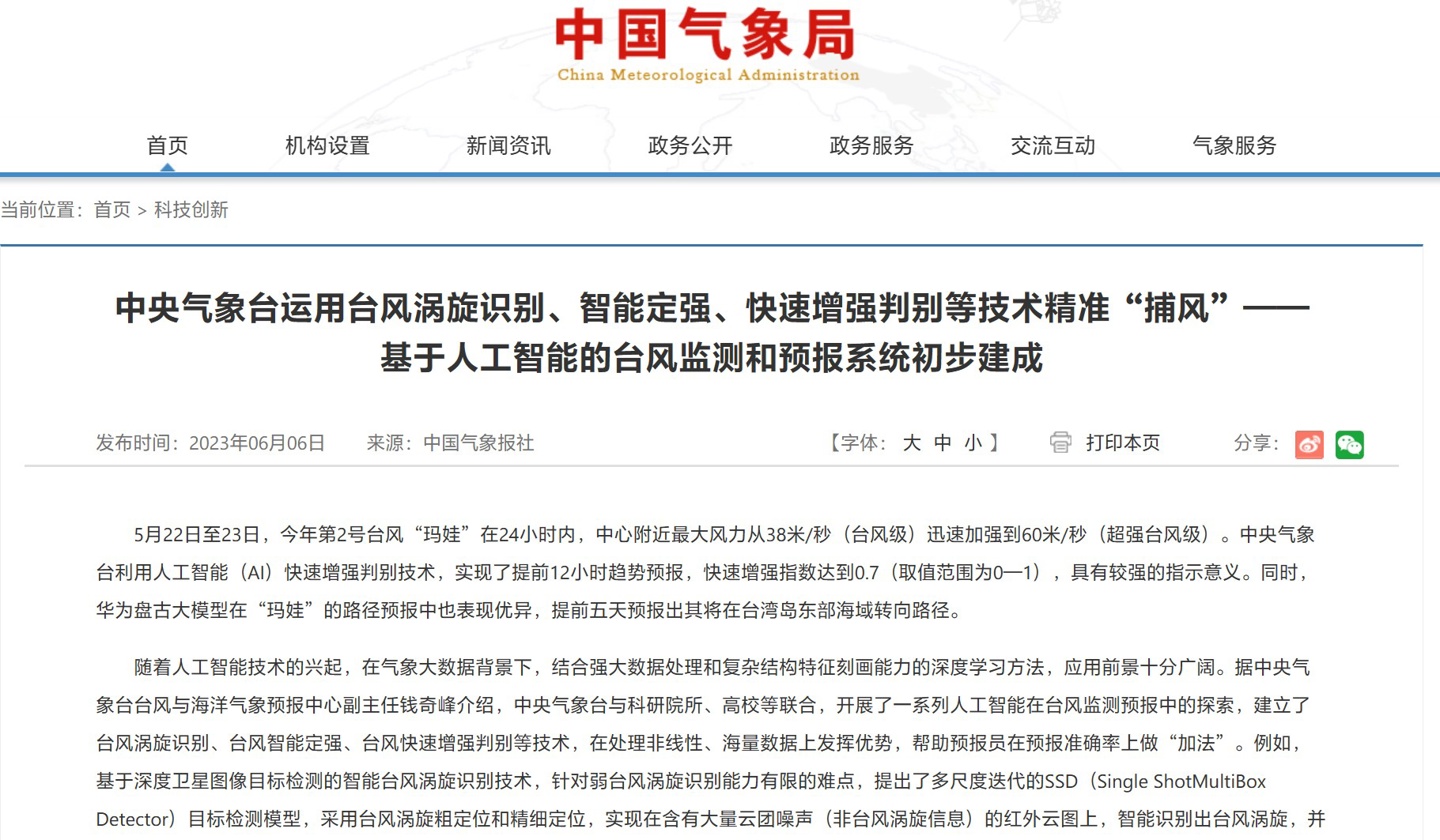Home >Technology peripherals >AI >Central Meteorological Observatory: AI-based typhoon monitoring and forecasting system has been initially completed
Central Meteorological Observatory: AI-based typhoon monitoring and forecasting system has been initially completed
- WBOYWBOYWBOYWBOYWBOYWBOYWBOYWBOYWBOYWBOYWBOYWBOYWBforward
- 2023-06-06 17:16:03997browse
According to news on June 6, the Central Meteorological Observatory announced today that it has initially built a typhoon monitoring and forecasting system based on artificial intelligence. This system can provide important technical support for improving the intelligence of my country's typhoon monitoring and forecasting business and expanding tropical cyclone business in multiple sea areas around the world.
Qian Qifeng, deputy director of the Typhoon and Marine Meteorological Forecasting Center of the Central Meteorological Observatory, said, "The Central Meteorological Observatory, in conjunction with various scientific research institutes, universities, etc., has carried out a series of explorations of artificial intelligence in typhoon monitoring and forecasting. And developed With technologies such as typhoon vortex identification, typhoon intelligent intensity determination, and typhoon rapid enhanced discrimination, it can take advantage of processing nonlinear and massive data and help forecasters increase forecast accuracy."

▲ Picture source China Meteorological Administration
Based on deep satellite image target detection, the Central Meteorological Observatory proposed a multi-scale iteration SSD (Single ShotMultiBox Detector) to address the difficulty of weak typhoon vortex identification capabilities. ) target detection model, which uses typhoon vortex coarse positioning and fine positioning to intelligently identify typhoon vortices and quickly locate them on infrared cloud images containing a large amount of cloud noise (non-typhoon vortex information). This technology has a recognition rate of nearly 100% for typhoons and above, and a recognition rate of 50% to 80% for weak vortices (tropical low pressure levels) with no obvious vortex characteristics.
According to Zhou Guanbo, chief forecaster of the Typhoon and Marine Meteorological Forecast Center of the Central Meteorological Observatory, by establishing a typhoon vortex identification model, a typhoon intelligent intensity determination model, and a typhoon rapid intensification identification model, the Central Meteorological Observatory has initially built a model based on artificial intelligence. The typhoon monitoring and forecasting system provides important technical support and reference for improving the intelligence of my country's typhoon monitoring and forecasting business and rapidly expanding the global multi-ocean tropical cyclone business.
The Central Meteorological Observatory stated that “the Central Meteorological Observatory’s Typhoon and Marine Meteorological Forecasting Center will continue to strengthen the application of artificial intelligence in the field of typhoon monitoring and forecasting” and further promote the integration of artificial intelligence technology in typhoon monitoring, forecasting and services to provide Precise monitoring and accurate forecasting of global typhoons provide innovative technical support.
IT House noticed that in 2019, the Central Meteorological Observatory and Beijing University of Posts and Telecommunications proposed an end-to-end visual intelligent typhoon intensity determination model. This model is based on the pre-trained convolutional neural network deep learning model. Extract satellite cloud image data to analyze features related to typhoon intensity, and then build a classification model and a similarity-based retrieval model based on the features to obtain decision results. Finally, by fusing the recognition results of the two models, the intensity, confidence and reference cloud images of the typhoon were obtained. This type of deep learning method can implicitly extract deep abstract complex features in images through machine analysis and learning of a large number of samples, and is now increasingly being used in typhoon intensity estimation.
The above is the detailed content of Central Meteorological Observatory: AI-based typhoon monitoring and forecasting system has been initially completed. For more information, please follow other related articles on the PHP Chinese website!
Related articles
See more- Technology trends to watch in 2023
- How Artificial Intelligence is Bringing New Everyday Work to Data Center Teams
- Can artificial intelligence or automation solve the problem of low energy efficiency in buildings?
- OpenAI co-founder interviewed by Huang Renxun: GPT-4's reasoning capabilities have not yet reached expectations
- Microsoft's Bing surpasses Google in search traffic thanks to OpenAI technology

